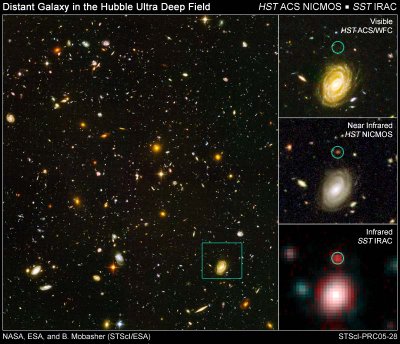Distant
Galaxy Invalidates the Big Bang Theory
The
Big Bang a focal point and foundation for some of mankindís theories in
astronomy, is now in conflict with photographic evidence returned from the Hubble
ultra deep field imaging. Astronomers must now ponder, how can galaxy with 8
times the mass of the Milky Way and mature stars exist if the universe is only
800 million years old? Answer, because the age of the universe is far older than
mankind can comprehend and only as we peer deeper into the universe with better
equipment, will galaxies far older than the predicted Big Bang be discovered? As
evidence mounts, scientists will start to lean towards the concepts of an
infinite universe and a renewal of galactic sectors by localized Big Bangs for
expansion and the formation of a Black Hole at the center of the galaxy initiating
compression. The news story below tells of the discovery, which gives reason to
consider other theories on the Big
Bang.
All Rights Reserved: ©
Copyright 2005
Distant Galaxy is Too Massive for the
BIG-Bang Theory
 |
|
Summary - (Sep 27, 2005)
The latest images released from the Hubble Space Telescope pinpoint an
enormous galaxy located almost 13 billion light-years away - at a time
when the Universe was only 800 million years old. This galaxy contains 8
times the mass of stars as the Milky Way, and really shouldn't exist
according to current astronomical theories. This research demonstrates
that mature stars and large galaxies formed much earlier than
astronomers had ever expected.
©©©©©©©©©©©©©©©©©©©©©©
Full Story - Distant galaxy in a Hubble Ultra Deep Field image. Image
credit: Hubble Space Telescope.
|
Two of NASA's Great Observatories, the Spitzer and
Hubble Space Telescopes, have teamed up to "weigh" the stars in
several distant galaxies. One of these galaxies, among the most distant ever
seen, appears to be unusually massive and mature for its place in the young
universe.
This came as a surprise to astronomers, as the earliest galaxies in the universe
are commonly thought to have been much smaller associations of stars that
gradually merged to build large galaxies like our Milky Way.
"This galaxy, named HUDF-JD2, appears to have bulked up quickly, within the
first few hundred million years after the big bang. It made about eight times
more mass in stars than are found in our own Milky Way, and then, just as
suddenly, it stopped forming new stars," said Bahram Mobasher of the Space
Telescope Science Institute, Baltimore and the European Space Agency, Paris.
The galaxy was pinpointed among approximately 10,000 others in a small patch of
sky called the Hubble Ultra Deep Field (UDF). The galaxy is believed to be about
as far away as the most distant known galaxies. It represents an era when the
universe was only 800 million years old. That is about five percent of the
universe's age of 14 billion years.
Scientists studying the UDF found this galaxy in Hubble's infrared images. They
expected it to be young and small, like other known galaxies at similar
distances. Instead, they found evidence the galaxy is remarkably mature and much
more massive, and its stars appear to have been in place for a long time.
Hubble's optical-light UDF image is the deepest image ever taken, yet this
galaxy was not evident. This indicates much of the galaxy's optical light has
been absorbed by traveling billions of light-years through intervening hydrogen
gas. The galaxy was detected using Hubble's Near Infrared Camera and
Multi-Object Spectrometer. It was also detected by an infrared camera on the
Very Large Telescope (VLT) at the European Southern Observatory. At those longer
infrared wavelengths, it is very faint and red.
The big surprise is how much brighter the galaxy is in even longer- wavelength
infrared images from the Spitzer Space Telescope. Spitzer is sensitive to the
light from older, redder stars, which should make up most of the mass in a
galaxy. The infrared brightness of the galaxy suggests it is massive. "This
would be quite a big galaxy even today," said Mark Dickinson of the
National Optical Astronomy Observatory, Tucson, Ariz. "At a time when the
universe was only 800 million years old,
it's positively GIGANTIC," he added.
Spitzer observations were also independently reported by Laurence Eyles from the
University of Exeter in the United Kingdom and Haojing Yan of the Spitzer
Science Center, Pasadena, Calif. They also revealed evidence for mature stars in
more ordinary, less massive galaxies at similar distances, when the universe was
less than one billion years old.
The new observations reported by Mobasher extend this notion of surprisingly
mature "baby galaxies" to an object which is perhaps 10 times more
massive, and which seemed to form its stars even earlier in the history of the
universe.
Mobasher's team estimated the distance to this galaxy by combining information
provided by the Hubble, Spitzer, and VLT observations. The relative brightness
of the galaxy at different wavelengths is influenced by the expanding universe
and allows astronomers to estimate its distance.
They can also get an idea of the make-up of the galaxy in terms of the mass and
age of its stars. It will take the next generation of telescopes, such as the
infrared James Webb Space Telescope, to confirm the galaxy's distance.
While astronomers generally believe most galaxies were built piecewise by
mergers of smaller galaxies, the discovery of this object suggests at least a
few galaxies formed quickly long ago. For such a large galaxy, this would have
been a tremendously explosive event of star birth. Mobasher's results will
appear in the Astrophysical Journal on Dec. 20.
Prime
Story courtesy of NASA
http://community-2.webtv.net/hotmail.com/prime137/BigBangDisproved/
Return
